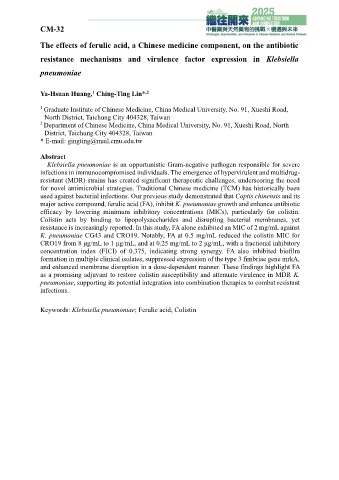Page 299 - 2025中醫藥與天然藥物聯合學術研討會-中醫藥與天然藥物的挑戰X機遇與未來大會手冊
P. 299
CM-32
The effects of ferulic acid, a Chinese medicine component, on the antibiotic
resistance mechanisms and virulence factor expression in Klebsiella
pneumoniae
1
Y a -Hsuan Huang, Ching-Ting Lin* ,2
1 Graduate Institute of Chinese Medicine, China Medical University, No. 91, Xueshi Road,
North District, Taichung City 404328, Taiwan
2 Department of Chinese Medicine, China Medical University, No. 91, Xueshi Road, North
District, Taichung City 404328, Taiwan
* E-mail: gingting@mail.cmu.edu.tw
Abstract
Klebsiella pneumoniae is an opportunistic Gram-negative pathogen responsible for severe
infections in immunocompromised individuals. The emergence of hypervirulent and multidrug-
resistant (MDR) strains has created significant therapeutic challenges, underscoring the need
for novel antimicrobial strategies. Traditional Chinese medicine (TCM) has historically been
used against bacterial infections. Our previous study demonstrated that Coptis chinensis and its
major active compound, ferulic acid (FA), inhibit K. pneumoniae growth and enhance antibiotic
efficacy by lowering minimum inhibitory concentrations (MICs), particularly for colistin.
Colistin acts by binding to lipopolysaccharides and disrupting bacterial membranes, yet
resistance is increasingly reported. In this study, FA alone exhibited an MIC of 2 mg/mL against
K. pneumoniae CG43 and CRO19. Notably, FA at 0.5 mg/mL reduced the colistin MIC for
CRO19 from 8 μg/mL to 1 μg/mL, and at 0.25 mg/mL to 2 μg/mL, with a fractional inhibitory
concentration index (FICI) of 0.375, indicating strong synergy. FA also inhibited biofilm
formation in multiple clinical isolates, suppressed expression of the type 3 fimbriae gene mrkA,
and enhanced membrane disruption in a dose-dependent manner. These findings highlight FA
as a promising adjuvant to restore colistin susceptibility and attenuate virulence in MDR K.
pneumoniae, supporting its potential integration into combination therapies to combat resistant
infections.
Keywords: Klebsiella pneumoniae; Ferulic acid; Colistin

